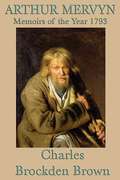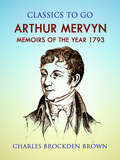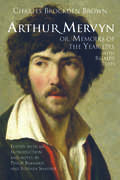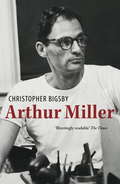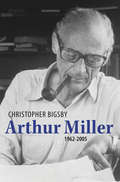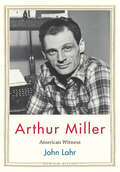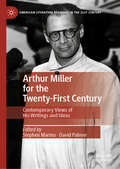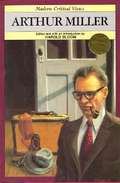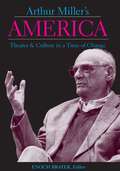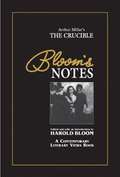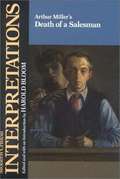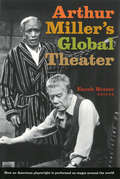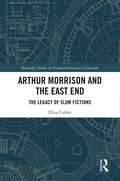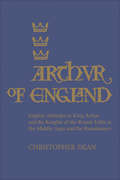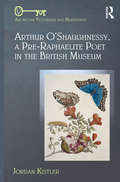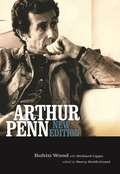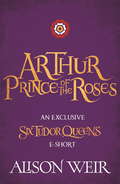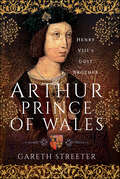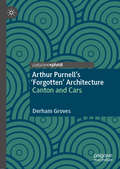- Table View
- List View
Arthur M.Sackler COLLOQUIA OF THE NATIONAL ACADEMY OF SCIENCES: Neural Signaling
by National Academy of ScienceThe National Academies Press (NAP)--publisher for the National Academies--publishes more than 200 books a year offering the most authoritative views, definitive information, and groundbreaking recommendations on a wide range of topics in science, engineering, and health.<P><P> Our books are unique in that they are authored by the nation's leading experts in every scientific field.
Arthur Mervyn
by Charles Brockden BrownSet during the epic Philadelphia yellow fever epidemic of 1793, Charles Brockden Brown's classic gothic novel Arthur Mervyn; or, Memoirs of the Year 1793 connects the outbreak with the upheavals of the revolutionary era and the murderous financial networks of Atlantic slavery.
Arthur Mervyn: Memoirs of the Year 1793 (Classics To Go)
by Charles Brockden BrownArthur Mervyn is a novel written by Charles Brockden Brown and published in 1799. It was one of Brown's more popular novels, and is in many ways representative of Brown's dark, gothic style and subject matter. (Wikipedia)
Arthur Mervyn; or, Memoirs of the Year 1793: With Related Texts
by Stephen Shapiro Charles Brockden Brown Philip BarnardSet during the epic Philadelphia yellow fever epidemic of 1793, Charles Brockden Brown's classic gothic novel Arthur Mervyn; or, Memoirs of the Year 1793 connects the outbreak with the upheavals of the revolutionary era and the murderous financial networks of Atlantic slavery.This edition of Arthur Mervyn offers selections from key contemporary texts as well as excerpts from Brown's own writings on slavery, race, and the uses of history in fiction.
Arthur Miller: 1962-2005
by Christopher BigsbyBiography of one of the greatest of modern playwrights, Arthur Miller (1915-2005).This is the long-awaited biography of one of the twentieth century's greatest playwrights whose postwar decade of work earned him international critical and popular acclaim.Arthur Miller was a prominent figure in American literature and cinema for over sixty years, writing a wide variety of plays - including The Crucible, A View from the Bridge, All My Sons, and Death of a Salesman - which are still performed, studied and lauded throughout the world.Born in 1915 to moderately affluent Jewish-American parents, Miller wrote during a fascinating time in American history. The Great Depression was a period of deprivation for many that left an indelible mark on the national psyche, and, like many, Miller found hope for the beleaguered common man in Communism. The Second World War elevated the common man to war hero, but when the Cold War subsequently began, the ugly elements of American conservatism freely persecuted writers and artists who had embraced Communism. Miller was among them. His refusal to give evidence against others to the notorious House Un-American Activities Committee in 1956 gave him a heroic role to play. In that same year, Arthur Miller momentously married the young actress Marilyn Monroe, a marriage that remains famous to this day. Christopher Bigsby's gripping, meticulously researched biography, based on boxes of papers made available to him before Miller's death, offers new insights into their marriage, and sheds new light on how their relationship informed Miller's subsequent great plays. After his death in 2005, many respected actors, directors and producers paid tribute to Miller, calling him 'the last great practitioner of the American stage'. Christopher Bigsby's supremely authoritative biography does full justice to Miller's life and art.
Arthur Miller: 1962-2005
by Christopher BigsbyThe second volume of the definitive biography of one of the greatest modern playwrights, Arthur Miller (1915-2005).The first volume of Christopher Bigsby's award-winning biography of Arthur Miller was hailed as a masterpiece and the definitive account of Miller's early years. This is the second half of Miller's captivating story, covering his life from 1962 to his death in 2005.In 1962, Miller's legacy was incomplete. Ahead lay eighteen plays, five films, a novella and a handful of stories. On a personal level, 1962 saw the death of his second wife, the iconographic Marilyn Monroe, and his marriage to the photographer Inge Morath who was to transform him as a writer and a person. A visit to Mauthaussen concentration camp and to the Frankfurt trials of Auschwitz-Birkenau guards moved the Holocaust to the centre of his attention and he became a more directly political person. Christopher Bigsby brilliantly and elegantly maps out the journey of Miller's life and work. Shedding new light on Miller's complexities, and revealing unknown facts about his public and private life, Bigsby shares new insights and perspectives crucial to an understanding of one of the world's greatest playwrights.
Arthur Miller: 1962-2005
by Christopher BigsbyAuthorised biography of one of the greatest of modern playwrights, Arthur Miller (1915-2005). This is the long-awaited authorised biography of one of the twentieth century's (and America's) greatest playwrights, whose accomplishment bears comparison with Eugene O'Neill and Tennessee Williams. A post-war decade of work earned him international critical and popular acclaim - 'All My Sons' (1947), 'Death of a Salesman' (1949), 'The Crucible' (1953) and 'A View from the Bridge' (1955) are modern classics of the theatre. Miller was born in 1915 and wrote during a fascinating time in American history. He matured during the Great Depression and like many found hope for the beleaguered common man in Communism in a country that was essentially deeply conservative. The Great Depression was a period of deprivation for many that left a mark upon the national psyche comparable to the mark the family feud of the American Civil War left upon the nation. The chill left by the shadow of sudden collapse of banks and businesses and farms was felt for many years after the US had become prosperous. The Second World War elevated the common man to war hero and it was not until Japan was defeated and the Cold War began that the ugly elements of American conservatism would freely persecute writers and artists who had embraced Communism, no matter if it had only been flirtatiously. Miller was among them. His refusal to name names and to co-operate with the notorious House of Un-American Activities gave him a heroic role to play. In that same year, 1956, Arthur Miller momentously got married a second time - to Marilyn Monroe. The biography ends shortly after her tragic death in 1962, and eloquently shows how their relationship informed Miller's great plays.
Arthur Miller: 1962-2005
by Christopher BigsbyThe second volume of the definitive biography of one of the greatest modern playwrights, Arthur Miller (1915-2005).The first volume of Christopher Bigsby's award-winning biography of Arthur Miller was hailed as a masterpiece and the definitive account of Miller's early years. This is the second half of Miller's captivating story, covering his life from 1962 to his death in 2005.In 1962, Miller's legacy was incomplete. Ahead lay eighteen plays, five films, a novella and a handful of stories. On a personal level, 1962 saw the death of his second wife, the iconographic Marilyn Monroe, and his marriage to the photographer Inge Morath who was to transform him as a writer and a person. A visit to Mauthaussen concentration camp and to the Frankfurt trials of Auschwitz-Birkenau guards moved the Holocaust to the centre of his attention and he became a more directly political person. Christopher Bigsby brilliantly and elegantly maps out the journey of Miller's life and work. Shedding new light on Miller's complexities, and revealing unknown facts about his public and private life, Bigsby shares new insights and perspectives crucial to an understanding of one of the world's greatest playwrights.
Arthur Miller: American Witness (Jewish Lives)
by John LahrA great theater critic brings twentieth-century playwright Arthur Miller&’s dramatic story to life with bold and revealing new insights &“New Yorker critic Lahr shines in this searching account of the life of playwright Arthur Miller. . . . It&’s a great introduction to a giant of American letters.&”—Publishers Weekly Distinguished theater critic John Lahr brings unique perspective to the life of Arthur Miller (1915–2005), the playwright who almost single-handedly propelled twentieth-century American theater into a new level of cultural sophistication. Organized around the fault lines of Miller&’s life—his family, the Great Depression, the rise of fascism, Elia Kazan and the House Committee on Un-American Activities, Marilyn Monroe, Vietnam, and the rise and fall of Miller&’s role as a public intellectual—this book demonstrates the synergy between Arthur Miller&’s psychology and his plays. Concentrating largely on Miller&’s most prolific decades of the 1940s, 1950s, and 1960s, Lahr probes Miller&’s early playwriting failures; his work writing radio plays during World War II after being rejected for military service; his only novel, Focus; and his succession of award-winning and canonical plays that include All My Sons, Death of a Salesman, and The Crucible, providing an original interpretation of Miller&’s work and his personality.
Arthur Miller for the Twenty-First Century: Contemporary Views of His Writings and Ideas (American Literature Readings in the 21st Century)
by Stephen Marino David PalmerArthur Miller for the Twenty-First Century: Contemporary Views of His Writings and Ideas brings together both established Miller experts and emerging commentators to investigate the sources of his ongoing resonance with audiences and his place in world theatre. The collection begins by exploring Miller in the context of 20th-century American drama. Chapters discuss Miller and Eugene O’Neill, Tennessee Williams, Edward Albee, David Mamet, and Sam Shepard, as well as thematic relationships between Miller’s ideas and the explosion of significant women and African American dramatists since the 1970s. Other essays focus more directly on interpretations of Miller’s individual works, not only plays but also essays and fiction, including a discussion of Death of a Salesman in China. The volume concludes by considering Miller and current cultural issues: his work for human rights, his depiction of American ideals of masculinity, and his anticipation of contemporary posthumanism.
Arthur Miller (Modern Critical Views)
by Harold BloomSelected essays about the author and his works.
Arthur Miller's America
by Enoch BraterPerspectives on America's greatest living playwright that explore his longstanding commitment to forging a uniquely American theater Arthur Miller's America collects new writing by leading international critics and scholars that considers the dramatic world of icon, activist, and playwright Arthur Miller's theater as it reflects the changing moral equations of his time. Written on the occasion of Miller's 85th year, the original essays and interviews in Arthur Miller's America treat the breadth of Miller's work, including his early political writings for the campus newspaper at the University of Michigan, his famous work with John Huston, Clark Gable and Marilyn Monroe on The Misfits, and his signature plays like Death of a Salesman and All My Sons.
Arthur Miller's Death of a Salesman (Modern Critical Interpretations)
by Harold BloomSelected essays.
Arthur Miller's Global Theater
by Enoch BraterNo American playwright is more revered on the international stage than Arthur Miller. In Arthur Miller’s Global Theater—a fascinating collection of new essays by leading international critics and scholars—readers learn how and why audiences around the world have responded to the work of the late theatrical icon. With perspectives from diverse corners of the globe, from Israel to Japan to South Africa, this groundbreaking volume explores the challenges of translating one of the most American of American playwrights and details how disparate nations have adapted meaning in Miller’s most celebrated dramas. An original and engaging collection that will appeal to theater aficionados, scholars, students, and all those interested in Miller and his remarkable oeuvre, Arthur Miller’s Global Theater illustrates how dramas such as Death of a Salesman, The Crucible, and A View from the Bridge developed a vigorous dialogue with new audiences when they crossed linguistic and national borders. In these times when problems of censorship, repressive regimes, and international discord are increasingly in the news, Arthur Miller’s voice has never been more necessary as it continues to be heard and celebrated around the world.
Arthur Morrison and the East End: The Legacy of Slum Fictions (Routledge Studies in Nineteenth Century Literature)
by Eliza CubittThis, the first critical biography of Arthur Morrison (1863-1945), presents his East End writing as the counter-myth to the cultural production of the East End in late-Victorian realism. Morrison’s works, particularly Tales of Mean Streets (1894) and A Child of the Jago (1896), are often discussed as epitomes of slum fictions of the 1890s as well as prime examples of nineteenth-century realism, but their complex contemporary reception reveals the intricate paradoxes involved in representing the turn-of-the-century city. Arthur Morrison and the East End examines how an understanding of the East End in the Victorian cultural imagination operates in Morrison’s own writing. Engaging with the contemporary vogue for slum fiction, Morrison redressed accounts written by outsiders, positioning himself as uniquely knowledgeable about a place considered unknowable. His work provides a vigorous challenge to the fictionalised East End created by his predecessors, whilst also paying homage to Charles Dickens, George Gissing, Walter Besant and Guy de Maupassant. Examining the London sites which Morrison lived in and wrote about, this book is an excursion not into the Victorian East End, but into the fictions constructed around it.
Arthur Murray's Popularity Book
by Arthur MurrayFirst published in 1944, The Popularity Book is a vintage guidebook full of wise and wonderful advice on living well, building poise and maintaining fulfilling relationships. Drawn from books, testimonials and magazines from the World War II era, this book shows the forthright common sense and romanticism of the “Greatest Generation”, a generation inspired by debonair role models such as Clark Gable, Cary Grant and Katharine Hepburn. As relevant today as it was in the 1940s, The Popularity Book offers counsel on being an unforgettably great date, devising a game-plan for making a man propose marriage, and pointers how to be charming. Compiled and originally published by Arthur Murray, who famously said he could teach anyone who could walk how to dance, it also features his iconic step-by-step footprint instructions on how to Samba, Fox Trot and Rumba divinely!
Arthur of England: English Attitudes to King Arthur and the Knights of the Round Table in the Middle Ages and the Renaissance
by Christopher DeanToday, popular imagination peoples the Middle Ages with damsels in distress and knights riding to their rescue. Of such knights, King Arthur and his companions are the most celebrated. It is certainly true that this is the time when the Arthurian story took shape and Arthurian literature flourished, and that most medieval historians included him in their histories of Britain, though some did so with a considerable degree of scepticism. But how widely was this literature known in its own day? How much credence did people generally place in this king who supposedly once ruled England? To answer these questions, Christopher Dean looks at medieval and Renaissance Arthurian literature in detail, and also examines contemporary chronicles and histories, chivalric theory and practice, popular myths and legends, folk-lore and place-names. The result is to show dramatically that Arthur was not at all as well known as popular belief today fancies. As a historical figure he was early discredited; had it not been for his artificial revival by the Tudor monarchy and the furor caused by the attack upon him by the 'foreigner' Polydore Vergil, which incensed many patriotic Englishmen, his credibility might have disappeared much sooner than it did. Except for Malory's work, medieval Arthurian literature, which often exists in no more than single manuscripts, did not have large audiences. And after 1500, only Edmund Spenser and Thomas Hughes attempted to write seriously on Arthurian themes. Among the ordinary citizens of England, Arthur was hardly known at all, any popular knowledge of him being almost entirely restricted to Wales, Devon, and Cornwall. Elsewhere in Britain the much more familiar figure was Robin Hood. For all the strength of the Arthurian legend as the ultimate medieval knight, he is essentially a modern hero.
Arthur O'Shaughnessy, A Pre-Raphaelite Poet in the British Museum (Among the Victorians and Modernists)
by Jordan KistlerArthur O'Shaughnessy's career as a natural historian in the British Museum, and his consequent preoccupation with the role of work in his life, provides the context with which to reexamine his contributions to Victorian poetry. O'Shaughnessy's engagement with aestheticism, socialism, and Darwinian theory can be traced to his career as a Junior Assistant at the British Museum, and his perception of the burden of having to earn a living outside of art. Making use of extensive archival research, Jordan Kistler demonstrates that far from being merely a minor poet, O'Shaughnessy was at the forefront of later Victorian avant-garde poetry. Her analyses of published and unpublished writings, including correspondence, poetic manuscripts, and scientific notebooks, demonstrate O'Shaughnessy's importance to the cultural milieu of the 1870s, particularly his contributions to English aestheticism, his role in the importation of decadence from France, and his unique position within contemporary debates on science and literature.
Arthur Penn: New Edition
by Barry Keith Grant Robin Wood Richard LippeArthur Penn--director of The Miracle Worker, Bonnie and Clyde, Alice's Restaurant, and Little Big Man--was at the height of his career when Robin Wood's analysis of the American director was originally published in 1969. Although Wood then considered Penn's career only through Little Big Man, Arthur Penn remains the most insightful discussion of the director yet published. In this new edition, editor Barry Keith Grant presents the full text of the original monograph along with additional material, showcasing Wood's groundbreaking and engaging analysis of the director. Of all the directors that Wood profiled, Penn is the only one with whom he developed a personal relationship. In fact, Penn welcomed Wood on the set of Little Big Man (1969), where he interviewed the director during production of the film and again years later when Penn visited Wood at home. Both interviews are included in this expanded edition of Arthur Penn, as are five other pieces written over a period of sixteen years, including the extended discussion of The Chase that was the second chapter of Wood's later important book Hollywood from Vietnam to Reagan. The volume also includes a complete filmography and a foreword by Barry Keith Grant. The fourth classic monograph by Wood to be republished by Wayne State University Press, this volume will be welcomed by film scholars and readers interested in American cinematic and cultural history.
Arthur Plantagenet: Henry VIII's Illegitimate Uncle
by Sarah-Beth WatkinsIllegitimate son to Edward IV and the uncle of Henry VIII, Arthur Plantagenet’s life is an intriguing story. Raised in his father’s court, he then became a trusted member of Henry VII’s household and after his death, was a prominent figure at the court of Henry VIII. Henry VIII treated his uncle well in the early years of his reign, making him vice-admiral and then Lord Deputy of Calais in 1533. Arthur did the best he could in his new position in Calais over seven years, including trying to maintain a relationship with Thomas Cromwell against a background of religious change, but there were numerous complaints about him and his paranoid nephew’s suspicions over his loyalty grew – culminating in Lisle’s arrest and imprisonment for two years with no legal reason. Arthur was released from the Tower in 1542, yet tragically died after receiving a diamond ring from his nephew. He was so excited that his heart – that ‘gentlest living heart’ – failed soon after. We owe much of what we know about Henry VIII’s uncle to the seizure and preservation of the Lisle Letters, an impressive collection of correspondence obtained at his arrest that has miraculously survived. Not only do they give details of Arthur’s life, but they are an amazing insight into the religious, political, culture and social background of the 16th century. Placed as he was, Arthur Plantagenet’s story gives a whole new, fresh perspective on a turbulent yet vibrant period of history.
Arthur: Prince of the Roses
by Alison WeirArthur: Prince of the Roses by bestselling historian Alison Weir is an e-short and companion piece to her stunning novel, Katherine of Aragon, the first in a spellbinding six-novel series about Henry VIII's Queens. Fans of Philippa Gregory and Elizabeth Chadwick will love this insight into the story of this ill-fated Tudor prince. 'You are the first prince of my line, the Tudor line.' Arthur, the first Tudor prince, is raised to believe that he will inherit a kingdom destined to be his through an ancient royal bloodline. He is the second Arthur, named for the legendary hero-king of Camelot. To be a worthy ruler, he must excel at everything - and show no weakness. But Arthur is not strong, and the hopes of England weigh heavy on his slight shoulders. And, all the while, his little brother Harry, the favoured, golden son, is waiting in the wings.Praise for Alison Weir and Katherine of Aragon: 'A tender understanding of and genuine sympathy for this proud, much-loved and honourable Queen. . . I was gripped [from] start to finish' Mavis Cheek'Well-researched and engrossing' Good Housekeeping'Yet again, Alison Weir has managed to intertwine profound historical knowledge with huge emotional intelligence, to compose a work that throws light on an endlessly fascinating historical figure. Yet her real gift in all of this is making it feel so fresh and alive' Earl Spencer'This exquisite book charts the rise and fall of Henry VIII's first wife, Katherine. . . A fascinating insight into this period of our history. Weir's undeniable strength is her immaculate description, enabling the reader to be transported back to Tudor England' Sun'Weir manages to untangle the complex web of 16th-century politics, shown through Katherine's duties as ambassador, and her astute reading of the games being played. This adds greatly to the heft of the character, demonstrating what a competent woman she was becoming' Herald Scotland'Katherine of Aragon, The True Queen is a true tour de force. Finely crafted, this novel is wonderful historical fiction and an outstanding introduction to the Six Tudor Queens series' Queen Anne Boleyn Blog'Known for bestselling historical biographies, Alison Weir is in command of her detail . . . her handling of Katherine's misery and dignified response to her predicament is very touching' Elizabeth Buchan, Daily Mail
Arthur, Prince of Wales: Henry VIII’s Lost Brother
by Gareth StreeterFor too long, Arthur Tudor has been remembered only for what he never became. The boy who died prematurely and paved the way for the revolutionary reign of his younger brother, Henry VIII. Yet, during his short life, Arthur was at the center of one of the most tumultuous periods of England’s history. At the time of his birth, he represented his father’s hopes for a dynasty and England’s greatest chance of peace. As he grew, he witnessed feuds, survived rebellion and became the focal point of an international alliance. From the threat of pretenders to West Country rebellions, the dramatic twists and turns of early Tudor England preoccupied Arthur’s thoughts. At a young age, he was dispatched to the Welsh border, becoming a figure head for a robust regional government. While never old enough to exercise full power in his dominion, he emerged as a figure of influence, beseeched by petitioners and consulted by courtiers. While the extent of his personal influence can only be guessed at, the sources that survive reveal a determined prince that came tantalizingly close to forging his future. Finally, after years of negotiation, delay and frustration, the prince finally came face to face with his Spanish bride, Katharine of Aragon. The young couple had shared a destiny since the cradle. Securing the hand of this prestigious pride for his son had been a center piece of Henry VII’s foreign policy. Yet, despite being 14 years in the making, the couple were to enjoy just five months together before Arthur succumbed to a mysterious illness. Arthur’s death at the age of 15 was not just a personal tragedy for his parents. It changed the course of the future and deprived England of one of the most educated and cultivated princes in their history. Arthur would never wear the crown the of England. But few Princes of Wales had been better prepared to rule. Arthur, Prince of Wales: Henry VIII’s Lost Brother shows that Arthur Tudor was more than a prince who died. He was a boy that really lived.
Arthur Purnell’s ‘Forgotten’ Architecture: Canton And Cars
by Derham Groves“Derham Groves has written this illuminating story of an exceptional but hitherto unsung Australian architect whose distinctive designs in China as well as his homeland may still be seen and enjoyed. In this book Groves has for the first time revealed some characteristic strands of Arthur Purnell’s talents, whereby his subject’s remarkable creativity is now clear for us to enjoy.” - Robert Irving, architecture historian and pupil of Arthur Purnell Arthur Purnell’s ‘Forgotten’ Architecture: Canton and Cars focuses on two early phases in the career of the much overlooked and underrated Australian architect, Arthur Purnell (1878–1964). In 1903, Purnell teamed up with the American engineer, Charles Paget (1874–1933) in Canton, China. Between 1903 and 1910, Purnell and Paget designed many important and impressive buildings, including the Arnhold, Karberg & Co. building (1907), one of the first reinforced concrete buildings in Southern China, and the South China Cement Factory (1907), which would later become the headquarters of Dr. Sun Yatsen (1866–1925), the first president of the Republic of China. Not many architects can design a cement factory fit for a president’s palace! When Purnell returned to Australia in 1910, he had to start again from scratch. As cars were taking over from horses in a big way, he saw that designing for cars would be the next big thing in architecture. The fledgling Australian car industry was full of colourful, larger-than-life characters like Col. Harley Tarrant (1860–1949), who built his first car in 1897 and Australia’s first petrol-fuelled car in 1901, and Alec Barlow Sr. (1880–1937), the archetypal dodgy car salesman. Purnell wanted in, designing many buildings for both men, including early car factories and car showrooms. In this unique book, Groves asks: why isn’t Arthur Purnell more famous?
Arthur Purnell’s ‘Forgotten’ Architecture: Canton and Cars
by Derham Groves“Derham Groves has written this illuminating story of an exceptional but hitherto unsung Australian architect whose distinctive designs in China as well as his homeland may still be seen and enjoyed. In this book Groves has for the first time revealed some characteristic strands of Arthur Purnell’s talents, whereby his subject’s remarkable creativity is now clear for us to enjoy.” - Robert Irving, architecture historian and pupil of Arthur PurnellArthur Purnell’s ‘Forgotten’ Architecture: Canton and Cars focuses on two early phases in the career of the much overlooked and underrated Australian architect, Arthur Purnell (1878–1964). In 1903, Purnell teamed up with the American engineer, Charles Paget (1874–1933) in Canton, China. Between 1903 and 1910, Purnell and Paget designed many important and impressive buildings, including the Arnhold, Karberg & Co. building (1907), one of the first reinforced concrete buildings in Southern China, and the South China Cement Factory (1907), which would later become the headquarters of Dr. Sun Yatsen (1866–1925), the first president of the Republic of China. Not many architects can design a cement factory fit for a president’s palace! When Purnell returned to Australia in 1910, he had to start again from scratch. As cars were taking over from horses in a big way, he saw that designing for cars would be the next big thing in architecture. The fledgling Australian car industry was full of colourful, larger-than-life characters like Col. Harley Tarrant (1860–1949), who built his first car in 1897 and Australia’s first petrol-fuelled car in 1901, and Alec Barlow Sr. (1880–1937), the archetypal dodgy car salesman. Purnell wanted in, designing many buildings for both men, including early car factories and car showrooms. In this unique book, Groves asks: why isn’t Arthur Purnell more famous?

